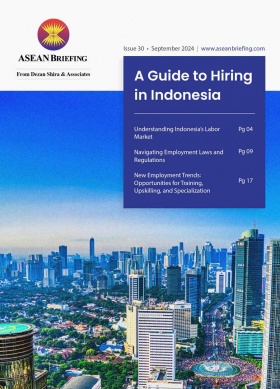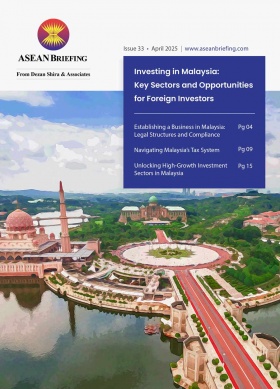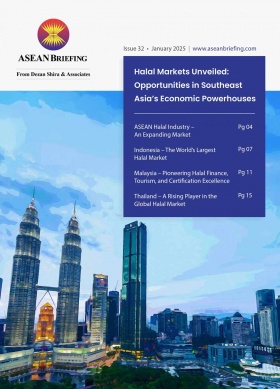Navigating US Tariffs: A Strategic Outlook for Indonesia
On April 2, 2025, the United States introduced sweeping new tariffs on several key trading partners, including a 32 percent tariff on goods imported from Indonesia. This development is part of a broader move by the U.S. administration to address longstanding trade imbalances and perceived unfair tariff structures. Indonesia, Southeast Asia’s largest economy, has long maintained a significant trade surplus with the United States. This has now become a point of contention, drawing the archipelago into the crosshairs of a renewed U.S. protectionist stance.
While the tariffs are framed by Washington as corrective, they pose serious risks to Indonesia’s trade-driven sectors. Given Indonesia’s deep integration into global value chains and its reliance on the U.S. market for specific goods, the implications are more than symbolic.
Businesses, policymakers, and investors must now navigate a more uncertain trade landscape.
Indonesia’s trade surplus with the United States and the justification for tariffs
The imposition of tariffs stems largely from the sizable and persistent trade surplus Indonesia holds over the United States. Since 2019, Indonesia has maintained an annual trade surplus with the U.S., peaking at US$18.89 billion in 2022. In 2024, this surplus remained substantial at US$16.84 billion, primarily driven by non-oil and gas exports such as footwear, clothing, machinery, and electrical equipment.
At the core of the U.S. grievance is not just the volume of the surplus, but structural trade imbalances and unequal market access. A key justification from the White House points to discrepancies under the Most-Favored-Nation (MFN) principle. For example, Indonesia imposes a 30 percent tariff on U.S. ethanol imports, while the United States levies only a 2.5 percent tariff on Indonesian ethanol.
Beyond tariffs, the U.S. has also cited a range of non-tariff barriers that restrict market access for American businesses. These include local content requirements across various sectors, complex import licensing regimes, and a 2024 regulation that requires natural resource exporters to repatriate earnings for transactions worth US$250,000 or more. U.S. officials argue that these barriers collectively undermine the principles of fair and reciprocal trade, making the current trade relationship untenable without significant reform.
Key sectors facing the greatest pressure
The tariffs threaten several of Indonesia’s top export sectors, which are highly reliant on the U.S. market. Electrical and electronic equipment, the country’s leading export to the U.S., generated US$4.83 billion in 2024 alone. While some of this is driven by intra-company trade and components for global supply chains, the 32 percent tariff could disrupt sales and trigger a realignment of procurement strategies.
Footwear, the second-largest export category at US$2.64 billion, is particularly vulnerable. Many global footwear brands source their products from Indonesian manufacturers, and the added cost burden could prompt them to shift production to other countries like Vietnam or Bangladesh.
Furniture exports are another area of concern. With over half of Indonesia’s furniture exports destined for the U.S. market, the new tariffs could render Indonesian products less competitive, affecting a major source of non-resource-based manufacturing exports.
Even palm oil, though not explicitly targeted, may face indirect consequences as Indonesia’s trade relations with the U.S. grow more strained.
Indonesia’s response: Dialogue over retaliation
The Indonesian government has so far chosen a measured approach in response to the U.S. action. Instead of retaliatory tariffs, Jakarta has prioritized diplomatic engagement. Indonesian officials have confirmed that they will pursue negotiations to resolve trade differences, signaling a desire to de-escalate tensions.
Beyond bilateral efforts, Indonesia is working through ASEAN channels to formulate a collective response, although each member state’s exposure to U.S. tariffs differs. Domestically, ministries such as Trade and Industry are assessing sectoral vulnerabilities and exploring targeted support, particularly for industries like apparel and footwear that employ millions of Indonesians.
There is also increased discussion within the government on accelerating structural reforms to improve investment competitiveness. These include regulatory streamlining, import-export facilitation, and incentive structures for affected sectors.
Strategic business and policy recommendations
Expanding into under-tapped markets
Indonesia must now adopt a proactive stance, both to mitigate the impact of the tariffs and to future-proof its trade strategy. One immediate opportunity lies in expanding into under-tapped markets. Trade with Africa, for instance, reached US$13.7 billion in 2023 and continues to grow. The 2nd Indonesia- Africa Forum in 2024 alone saw a 496.7 percent increase in export commitments compared to 2018, rising from US$568 million to US$3.5 billion. Key partners include Egypt, Nigeria, South Africa, and Kenya, with top exports like palm oil, motor vehicles, and electronics.
South America is another promising frontier. In 2023, Indonesia exported US$1.58 billion worth of goods to Brazil, including coconut oil and broadcasting equipment, and US$347 million to Chile, primarily in automotive and footwear products. These markets offer scale, growth potential, and room for diversification.
Unlocking investment through regulatory reform
For this expansion to succeed, structural reforms at home must accompany trade missions abroad. One area of urgent attention is the current minimum capital requirement of 10 billion rupiah (US$700,000) for foreign-owned companies. Reducing this threshold would improve ease of entry for small and mid-sized foreign investors, especially those looking to source or manufacture goods for new regions.
Strengthening MSMEs through digitalization
Another priority is the digitalization and modernization of Indonesian MSMEs. As of 2023, 20.99 million MSMEs had already adopted digital platforms, and the government aims to bring that number to 30 million by 2024—representing 46.7 percent of all MSMEs. Continued progress in this direction can improve productivity, quality control, and export readiness, especially for sectors like fashion, furniture, and processed foods.
Improving Indonesia’s tax-to-GDP ratio
Another long-term reform worth prioritizing is enhancing Indonesia’s tax-to-GDP ratio, which remains among the lowest in Southeast Asia. As of October 2024, Indonesia’s tax-to-GDP ratio was 10.02 percent, a slight decline from 10.21 percent in 2023. The government has set a target to increase this to 12 percent by 2025. Achieving this goal will be critical for building the fiscal capacity to fund trade-related infrastructure, industrial support programs, and institutional reforms necessary to strengthen Indonesia’s export ecosystem.
Enhancing trade diplomacy and bilateral agreements
Indonesia can further mitigate the risks from U.S. tariffs by strengthening its trade diplomacy. Beyond maintaining open lines with Washington, the government can accelerate the pursuit of bilateral and multilateral trade agreements with other key regions. These include agreements with the Gulf Cooperation Council (GCC), Mercosur, and further leveraging frameworks like the Indo-Pacific Economic Framework for Prosperity (IPEF).
Progress is already underway. Negotiations for the Indonesia–GCC Free Trade Agreement began in 2024, with promising rounds held in Jakarta and Riyadh focused on expanding exports of motor vehicles, palm oil, electronics, and apparel. Additionally, the EU–Mercosur Free Trade Agreement, concluded in December 2024, serves as a blueprint for Indonesia to engage similar markets in South America.
Such efforts would broaden Indonesia’s access to alternative markets and reduce overreliance on any single trading partner.
Investing in trade infrastructure and supply chains
Long-term trade resilience also depends on the strength of Indonesia’s logistics and supply chain ecosystem. Significant infrastructure investments are already in progress. The government plans to allocate roughly US$25.5 billion over the next decade to build an inter-island electricity super grid, enhancing connectivity and supporting future industrial zones.
As of October 2024, 1,235 kilometers of the Trans-Sumatra Toll Road have been completed—part of a planned 2,818-kilometer network that will reduce logistics costs across Sumatra. Port efficiency is also improving. Between 2022 and 2023, digitalization efforts reached 14 major ports, with expansion planned for 246 ports by the end of 2024. These upgrades are expected to reduce bottlenecks, improve transparency, and lower logistics costs for exporters.
These infrastructure and logistics reforms will not only support diversification efforts but also attract international firms looking to relocate parts of their operations to more cost-effective and stable environments.
Taking a wait-and-see approach
In the immediate aftermath of the April 2 announcement, businesses began bracing for the impact of the 32 percent tariff on Indonesian goods. However, in a significant turn of events, the U.S. administration announced a 90-day pause on the tariffs on April 9, 2025, temporarily suspending their implementation to allow room for negotiations. While this reprieve has eased short-term pressure, it also introduces a window of uncertainty during which both sides are expected to pursue dialogue.
Indonesia has responded proactively. Finance Minister Sri Mulyani Indrawati acknowledged that the proposed tariffs could shave off 0.3 to 0.5 percentage points from Indonesia’s economic growth, but emphasized that the delay presents an opportunity to mitigate these risks through diplomacy. As part of its goodwill measures, the Indonesian government has announced concessions—such as lowering import taxes on electronics and steel—and is preparing to send a high-level delegation to Washington, D.C. on April 17 to negotiate.
This diplomatic push reflects Jakarta’s intention to avoid escalation and preserve economic stability. Still, businesses in sectors most exposed to the U.S. market—such as footwear, apparel, furniture, and electronics—should continue to assess potential disruptions. Exporters are advised to engage U.S. buyers in renegotiating terms, run tariff stress tests, and explore relocation options to ASEAN partners less affected by U.S. protectionism.
Legal teams should remain on alert, particularly for updates on U.S. customs classifications and any compliance risks related to rules of origin.
A critical window for strategic action
While the 90-day pause defers immediate economic shocks, it should not delay Indonesia’s long-term trade recalibration. The current landscape presents an inflection point—Indonesia must choose between reactive measures and transformative reforms. This moment of reprieve should be used to accelerate trade diversification, deepen structural reforms, and enhance trade resilience.
About Us
ASEAN Briefing is one of five regional publications under the Asia Briefing brand. It is supported by Dezan Shira & Associates, a pan-Asia, multi-disciplinary professional services firm that assists foreign investors throughout Asia, including through offices in Jakarta, Indonesia; Singapore; Hanoi, Ho Chi Minh City, and Da Nang in Vietnam; besides our practices in China, Hong Kong SAR, India, Italy, Germany, and USA. We also have partner firms in Malaysia, Bangladesh, the Philippines, Thailand, and Australia.
Please contact us at asean@dezshira.com or visit our website at www.dezshira.com and for a complimentary subscription to ASEAN Briefing’s content products, please click here.
This article was originally published on April 7 and has since been updated to reflect the latest developments, including the U.S. decision to pause the tariffs for 90 days.








